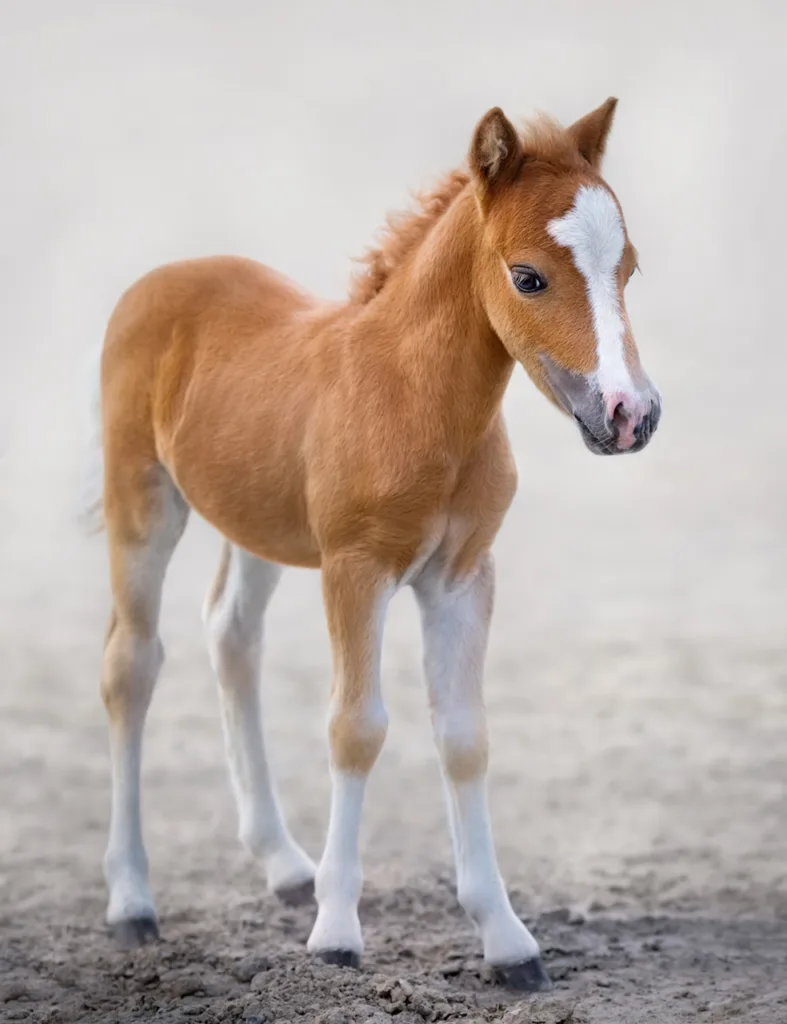Whether you are a horse-lover or not, it’s impossible not to fall in love with Miniature Horses, and this week at HOY saw the Miniature classes get the biggest supporter turnout of all! Any Miniature Horse owner will surely admit that it’s not just the petite nature of these pint-sized equines that they love, but their characters and larger than life personalities too.
According to The British Miniature Horse Society, a Miniature Horse “should be a perfectly scaled down version of a quality riding horse […] and should have the same conformation and movement as would be desirable in its full sized counterpart. It is definitely not a dwarf or under-sized pony.”

History
Miniature Horses have a fascinating history that dates back to 17th-century Europe, where they were bred as pets for nobility. Over time, selective breeding refined their size while maintaining correct conformation and horse-like proportions.
However, from the 18th century onwards, their path took them from pets to working animals, and they were subjected to back-breaking hard work.
In 1838, a coal mine in Northern England flooded, drowning 26 children who were working in the dark depths. Within a few years, the British Parliament passed an act banning children under 10 years old, as well as women, from working underground. The industry needed to replace the tiny workers, and ‘Pit Ponies’ were perfect for the job.
Fondly known as ‘Pit Ponies’, these working horses were selectively bred to perform the gruelling long hours underground. Strong, sure-footed, hardy and intelligent, these ‘Pit Ponies’ are the forefathers of the Miniature Horses we know today. The ‘Pit Ponies’ were prized for their strength in comparison to size, as they could squeeze into low and narrow roadways to access the coal face and pull heavily laden carts back to the ‘flats’ (a slightly more open area underground), where larger ponies would take the coal to the surface. Training was rigorous, and only those who could adapt to a life underground were accepted.
According to the National Coal Mining Museum for England, these Miniature Horses were “trained in the following five areas: being harnessed; pulling a heavy weight; turning around in a small space; opening the ventilation doors with their heads and; responding to verbal commands. […] Short names were popular as the pony could respond quickly to a verbal command”.
Besides being physically strong and able to remain sound despite the conditions, these Miniature Horses had to be incredibly hardy mentally. They endured long days of very tough work in completely unnatural conditions, often suffering from respiratory ailments and loss of eyesight due to their work underground with little to no natural light. Despite the conditions, miners have reported that working alongside the horses and ponies underground made all the difference in their daily lives, with their quirky personalities and big hearts; a trait which surely kept the breed alive after the working horses and ponies were replaced by machinery and modern mining techniques.
Later, the breed was further developed in the United States, where careful breeding programmes solidified its characteristics. Today, Miniature Horses are found worldwide and are popular as companion animals, therapy horses, and show competitors.

Breed standard and characteristics
Miniature Horses must not exceed 86–97 cm in height, depending on the breed registry. They should exhibit correct conformation, with a balanced and proportional body, strong legs, and an elegant head. Their coat comes in all equine colours and patterns.
Despite their small size, Miniature Horses possess the same anatomical structure as full-sized horses and should not be confused with ponies. Their movement is graceful, and they have an intelligent and friendly expression.
One of the Miniature Horse’s most endearing qualities is its temperament. They are known for their affectionate, trainable, and social nature. Their intelligence makes them excellent candidates for therapy work, where they provide emotional support to individuals in hospitals, nursing homes, and schools.
Miniature Horses also excel in a variety of disciplines, including:
- Driving: Many Miniature Horses are trained to pull small carts and participate in competitive driving events.
- In-hand Showing: Their beauty and precision in movement make them ideal for halter and liberty classes.
- Companion animals: Due to their manageable size and friendly nature, they are popular as family pets and companions.

Did you know?
Miniature Horses make excellent ‘Guide-Horses’ as an alternative service animal to aid blind and/or disabled individuals. Due to their longer working life span, intelligence, and docile nature, Guide-Horses are becoming increasingly popular internationally. Guide Horses are treasured and trusted due to their focussed demeanour and excellent vision. Many older people have reported that a Guide-Horse is much easier to handle than a boisterous puppy! Combined with high stamina and a great memory, it comes as no surprise that these smart little horses have found new jobs in our modern world.
Care and management
Although Miniature Horses require less space and feed than larger breeds, they still need proper care, including:
- A balanced diet based around forage that is appropriate for their size and activity level.
- Regular hoof care, dental care, and vaccinations.
- Adequate exercise to prevent obesity and maintain health.
- Companionship from conspecifics and plenty of turnout in the paddock.

Miniature Horses in South Africa
The Miniature Horse has a growing presence in South Africa. Devoted breeders ensure quality bloodlines and uphold international breed standards. The SA Miniature Horse Society oversees breeding, registration, and shows in the country.

